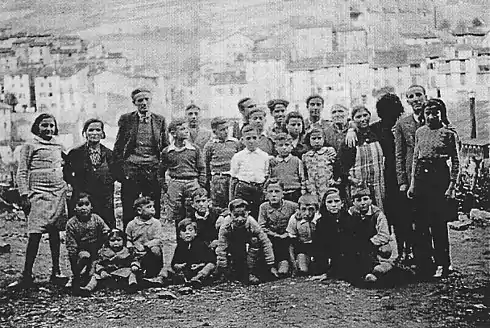Evacuation of children in the Spanish Civil War
As the Spanish Civil War proceeded on the Northern front (from 1937 onwards), the Spanish Republican authorities arranged the evacuation of children, with more regard for ideology than the welfare of the children some of whom had insufficient documentation to enable their repatriation.

Evacuations
These Spanish War children were shipped to Britain, Belgium, the Soviet Union, other European countries and Mexico. These children were referred to as "Basque refugees", but included also non-Basques. They were embarked in Bilbao (Santurtzi) on boats chartered by the Basque government, loyal to the Republic. Those in Western European countries were able to return to their families after the war, but those in the Soviet Union, from Communist families, were forbidden to return – by Stalin and by Franco. The first opportunity for most of them to do so came in 1956, three years after Stalin's death. They lived in Soviet orphanages and were regularly transferred from one orphanage to another according to the progress of the Second World War. Thus they experienced the War and its effects on the Soviet Union at first hand.[1]
Stoneham Camp in England
Just under 4,000 children arrived at the Southampton Docks on 23 May 1937. They travelled to Britain on the steamship Habana. The ship had been equipped to accommodate 800 passengers, but this voyage consisted of 3,886 children, 96 teachers, 118 assistants and 16 Catholic priests.[2] All the children and accompanying adults were housed in a single, large refugee camp in North Stoneham, Eastleigh, near Southampton.The construction of the camp at North Stoneham had been finished only two days prior to their arrival. A local farmer, Mr Brown, had provided three of his fields to be used for the Basque children's camp. Work on the camp had begun two weeks before, but the estimated numbers had then been only 2,000; the number was then increased to an expected 4,000. The camp and the sleeping tents were overcrowded. Sanitation was also a problem in the beginning as the children had been living through war and their hygienic habits had been disrupted by their turbulent lives. Even with the cramped conditions illness was not a large problem within the camp.[3]
The children were under the overall care of the Basque Children's Committee (BCC), part of the National Joint Committee for Spanish Relief (NJCSR) a cross-party organization that co-ordinated aid to Spain. The plan was to move the refugees out of the camp and disperse them into 'colonies' throughout Britain. These 'colonies' consisted of groups of children each with an accompanying Spanish teacher and assistants. They were housed in both large and small houses that were lent, or otherwise made available; some colonies were large - a hundred or more children, and some housed only a dozen or so. By September all of the children were moved into these colonies. Several hundred were taken in by The Salvation Army; the Catholic Church took about a third of the children, the rest were cared for and supported by many organizations including churches, political and humanitarian groups, local associations, businesses and individuals and other volunteers.
As the war in Spain progressed and areas became safer, the children started to be repatriated; the first few after barely a month. The Spanish Civil War ended on 1 April 1939, to be followed rapidly by the beginning of the Second World War in September. By this time only some 400 children remained in Britain, and by 1948 only 280 remained.[4] Throughout their stay and the subsequent repatriations, those aged 16 and above were allowed to decide whether or not they wanted to leave the country. Some had to stay because their parents had been killed or imprisoned, others stayed by choice and made their lives in Britain.[5]
Some of the refugees became professional footballers, including Sabino Barinaga, Emilio Aldecoa, José Gallego and Raimundo Lezama.[6][7][8][9]
In popular media
Luis de Castresana was evacuated to France and Belgium. In 1966, he published the novel El otro árbol de Guernica ("The other Gernika tree") inspired by his refugee experiences. Pedro Lazaga directed its film version in 1969.
References
- "'The Traitor' by Curzio Malaparte, translated by Walter Murch". London Review of Books. 33 (15): 32–34. 28 July 2011. Retrieved 5 August 2016.
- Hoare, Gerald (23 February 2017). "Passengers on the 'Habana'".
- Taylor, Richard (16 October 1937). "Typhoid Fever In The Basque Refugee Camp". The British Medical Journal. BMJ Publishing Group. 2 (4006): 760–761. JSTOR 25367539. PMC 2087513.
- Hoare, Gerald. "Names of Basque Children (Niños) who remained in Great Britain, 1948".
- "History of the Colonies". Basque Children of '37 Association UK. Retrieved 5 August 2016.
- Herbert, Ian (6 September 2015). "A Spanish refugee boy 78 years ago blazed the trail for David Silva and Cesc Fabregas". The Independent. Retrieved 11 June 2018.
- "First foreign footballers: Spain's Emilio Aldecoa". Football365. 16 March 2018. Retrieved 11 June 2018.
- Westland, Naomi (26 April 2017). "When football welcomed refugees". Amnesty International. Retrieved 11 June 2018.
- Sabino Barinaga, autor del primer gol en el Bernabéu (Sabino Barinaga, scorer of first goal at the Bernabéu); El País, 21 May 1988 (in Spanish)
External links
- "Basque Children of '37 Association UK". basquechildren.org.
- "The Spanish Civil War: Basque Refugee Children (1936–39)". Historical Boys' Clothing.